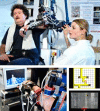Effects of intensive arm training with the rehabilitation robot ARMin II in chronic stroke patients: four single-cases
- PMID: 20017939
- PMCID: PMC2807864
- DOI: 10.1186/1743-0003-6-46
Effects of intensive arm training with the rehabilitation robot ARMin II in chronic stroke patients: four single-cases
Abstract
Background: Robot-assisted therapy offers a promising approach to neurorehabilitation, particularly for severely to moderately impaired stroke patients. The objective of this study was to investigate the effects of intensive arm training on motor performance in four chronic stroke patients using the robot ARMin II.
Methods: ARMin II is an exoskeleton robot with six degrees of freedom (DOF) moving shoulder, elbow and wrist joints. Four volunteers with chronic (>or= 12 months post-stroke) left side hemi-paresis and different levels of motor severity were enrolled in the study. They received robot-assisted therapy over a period of eight weeks, three to four therapy sessions per week, each session of one hour.Patients 1 and 4 had four one-hour training sessions per week and patients 2 and 3 had three one-hour training sessions per week. Primary outcome variable was the Fugl-Meyer Score of the upper extremity Assessment (FMA), secondary outcomes were the Wolf Motor Function Test (WMFT), the Catherine Bergego Scale (CBS), the Maximal Voluntary Torques (MVTs) and a questionnaire about ADL-tasks, progress, changes, motivation etc.
Results: Three out of four patients showed significant improvements (p < 0.05) in the main outcome. The improvements in the FMA scores were aligned with the objective results of MVTs. Most improvements were maintained or even increased from discharge to the six-month follow-up.
Conclusion: Data clearly indicate that intensive arm therapy with the robot ARMin II can significantly improve motor function of the paretic arm in some stroke patients, even those in a chronic state. The findings of the study provide a basis for a subsequent controlled randomized clinical trial.
Figures




Similar articles
-
A crossover pilot study evaluating the functional outcomes of two different types of robotic movement training in chronic stroke survivors using the arm exoskeleton BONES.J Neuroeng Rehabil. 2013 Dec 19;10:112. doi: 10.1186/1743-0003-10-112. J Neuroeng Rehabil. 2013. PMID: 24354476 Free PMC article. Clinical Trial.
-
Robot-Assisted Arm Training in Chronic Stroke: Addition of Transition-to-Task Practice.Neurorehabil Neural Repair. 2019 Sep;33(9):751-761. doi: 10.1177/1545968319862558. Epub 2019 Jul 22. Neurorehabil Neural Repair. 2019. PMID: 31328671 Clinical Trial.
-
Three-dimensional, task-specific robot therapy of the arm after stroke: a multicentre, parallel-group randomised trial.Lancet Neurol. 2014 Feb;13(2):159-66. doi: 10.1016/S1474-4422(13)70305-3. Epub 2013 Dec 30. Lancet Neurol. 2014. PMID: 24382580 Clinical Trial.
-
Effects of Robot-Assisted Therapy for the Upper Limb After Stroke.Neurorehabil Neural Repair. 2017 Feb;31(2):107-121. doi: 10.1177/1545968316666957. Epub 2016 Sep 24. Neurorehabil Neural Repair. 2017. PMID: 27597165 Review.
-
Robot-aided neurorehabilitation: a robot for wrist rehabilitation.IEEE Trans Neural Syst Rehabil Eng. 2007 Sep;15(3):327-35. doi: 10.1109/TNSRE.2007.903899. IEEE Trans Neural Syst Rehabil Eng. 2007. PMID: 17894265 Free PMC article. Review.
Cited by
-
A BMI-based occupational therapy assist suit: asynchronous control by SSVEP.Front Neurosci. 2013 Sep 23;7:172. doi: 10.3389/fnins.2013.00172. eCollection 2013. Front Neurosci. 2013. PMID: 24068982 Free PMC article.
-
Assessment of Motor Control during Three-Dimensional Movements Tracking with Position-Varying Gravity Compensation.Front Neurosci. 2017 May 16;11:253. doi: 10.3389/fnins.2017.00253. eCollection 2017. Front Neurosci. 2017. PMID: 28559788 Free PMC article.
-
Valid and reliable instruments for arm-hand assessment at ICF activity level in persons with hemiplegia: a systematic review.BMC Neurol. 2012 Apr 12;12:21. doi: 10.1186/1471-2377-12-21. BMC Neurol. 2012. PMID: 22498041 Free PMC article.
-
SEFRE: Semiexoskeleton Rehabilitation System.Appl Bionics Biomech. 2016;2016:8306765. doi: 10.1155/2016/8306765. Epub 2016 Aug 4. Appl Bionics Biomech. 2016. PMID: 27578961 Free PMC article.
-
Robot-aided therapy for upper limbs in patients with stroke-related lesions. Brief report of a clinical experience.J Neuroeng Rehabil. 2011 Apr 9;8:18. doi: 10.1186/1743-0003-8-18. J Neuroeng Rehabil. 2011. PMID: 21477331 Free PMC article.
References
-
- Thorvaldsen P, Asplund K, Kuulasmaa K, Rajakangas AM, Schroll M. Stroke incidence, case fatality, and mortality in the WHO MONICA project. World Health Organization Monitoring Trends and Determinants in Cardiovascular Disease. Stroke. 1995;26:361–367. - PubMed
-
- Rosamond W, Flegal K, Friday G, Furie K, Go A, Greenlund K, Haase N, Ho M, Howard V, Kissela B. Heart disease and stroke statistics--2007 update: a report from the American Heart Association Statistics Committee and Stroke Statistics Subcommittee. Circulation. 2007;115:e69–171. doi: 10.1161/CIRCULATIONAHA.106.179918. - DOI - PubMed
-
- Maeurer HC, Diener HC. Der Schlaganfall. Stuttgart: Georg Thieme Verlag; 1996.

